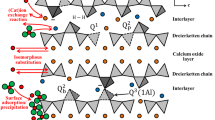Abstract
Laboratory-hydrolyzed and commercial OH-Al solutions were characterized using kinetics of Al-ferron color development, kinetics of structural OH neutralization with H+, 27A1 NMR spectroscopy, and sulfate precipitation. The results showed that the Al13 complexes having the Keggin structure were dominant only in fresh, laboratory-hydrolyzed OH-A1 solutions of OH/A1 molar ratio = 1.8 and above. These species gradually converted to other polynuclear forms that reacted with ferron slowly, were not detectable by 27A1 NMR spectroscopy, and yielded different basic Al sulfates following Na2SO4 addition. These more stable complexes can best be interpreted to have a Al(OH)3-fragment structure. In the three commercial aluminum chlorohydrate (ACH) solutions studied, Al13 complexes accounted for a small portion of the total Al present. More than 80% of the Al was present as species that were not detectable with NMR spectroscopy and resembled the slow-reacting complexes in aged, laboratory-hydrolyzed OH-Al solutions. Small portions of the slow-reacting complexes appeared to be submicron particulates that acted as nuclei for gibbsite formation or aggregates of Al13 complexes that dispersed to Al13 upon dilution. Polyaluminum chloride (PA) solution resembled the moderately aged laboratory-hydrolyzed OH-Al solutions.
Similar content being viewed by others
References
Akitt, J. W. and Farthing, A. (1981) Aluminum-27 nuclear magnetic resonance studies of the hydrolysis of alumi-num(III). Part 4. Hydrolysis using sodium carbonate: J. Chem. Soc. Dalton Trans. 1981, 1617–1623.
Bersillon, J., Hsu, Pa Ho, and Fiessinger, F. (1980) Characterization of hydroxy-aluminum solutions: Soil Sci. Soc. Amer. J. 44, 630–634.
Bertsch, P. M. (1987) Conditions for Al13 polymer formation in partially neutralized Al solutions: Soil Sci. Soc. Amer. J. 51, 825–828.
Bertsch, P. M. (1989) Aqueous polynuclear aluminum species: in The Environmental Chemistry of Aluminum, G. Sposito, ed., CRC Press Inc., Boca Raton, Florida.
Bertsch, P. M., Thomas, G. H., and Barnhisel, R. I. (1986) Characterization of hydroxy-aluminum solutions by aluminum-27 nuclear magnetic resonance spectroscopy: Soil Sci. Soc. Amer. J. 50, 825–830.
Buffle, J., Parthasarathy, N., and Haerdi, W. (1985) Importance of speciation methods in analytical control of water treatment processes with application to fluoride removal from waste waters: Water Res. 19, 7–23.
Denney, D. and Hsu, Pa Ho (1986) 27Al nuclear magnetic resonance and ferron kinetic studies of partially neutralized AlCl3 solutions: Clays & Clay Minerals 34, 604–607.
Hesterberg, D. and Reed, M. (1991) Volumetric treatment efficiencies of some commercial clay stabilizers: SPE Prod. Eng. 6, 57–62.
Hsu, Pa Ho (1988) Mechanism of gibbsite crystallization from partially neutralized aluminum chloride solutions: Clays & Clay Minerals 36, 25–30.
Hsu, Pa Ho (1989) Aluminum Hydroxides and Oxyhydroxides: in Minerals in Soil Environments: 2nd ed., J. B. Dixon and S. W. Weed, eds., Soil Science Society of America, Madison, Wisconsin, 331–378.
Hsu, Pa Ho (1992) Reaction of OH-Al polymers with smectites and vermiculites: Clays & Clay Minerals 40, 300–305.
Hsu, Pa Ho and Cao, Dan-Xia (1991) Effects of acidity and hydroxy lamine hydrochloride on the determination of aluminum with ferron: Soil Sci. 152, 210–219.
Johansson, G. (1960) On the crystal structures of some basic aluminum salts: Acta Chem. Scand. 14, 771–773.
Johansson, G. (1963) On the crystal structures of basic aluminum sulfate, 13Al2O3 6SO3 H2O: Ark. Kemi. 20, 321–342.
Pinnavaia, T. J. (1983) Intercalated clay catalysts: Science 220, 365–371.
Pinnavaia, T. J., Tzou, Ming-Shin, Landau, S. D., and Ray-thatha, R. H. (1984) On the pillaring and delamination of smectite clay catalysts by polyoxo cations of aluminum: J. Mol. Catal. 27, 195–212.
Reed, M. (1972) Stabilization of formation clays with hy-droxy-aluminum solutions: J. Pet. Tech. 24, 860–864.
Teagarden, D. L., Kozlowski, J. F., White, J. L., and Hem, S. L. (1981) Aluminum chlorohydrate I. Structure studies: J. Pharma. Sci. 70, 758–761.
Tsai, Ping Ping and Hsu, Pa Ho (1984) Studies of aged OH-Al solutions using kinetics of Al-ferron reactions and sulfate precipitation: Soil Sci. Soc. Amer. J. 48, 59–65.
Tsai, Ping Ping and Hsu, Pa Ho. (1985) Aging of partially neutralized aluminum solutions of NaOH/Al molar ratio = 2.2: Soil Sci. Soc. Amer. J. 49, 1060–1065.
Author information
Authors and Affiliations
Additional information
New Jersey Agricultural Experiment Station Publication No. D-07424-1-93.
Rights and permissions
About this article
Cite this article
Wang, WZ., Hsu, P.H. The Nature of Polynuclear Oh-Al Complexes in Laboratory-Hydrolyzed and Commercial Hydroxyaluminum Solutions. Clays Clay Miner. 42, 356–368 (1994). https://doi.org/10.1346/CCMN.1994.0420313
Received:
Accepted:
Published:
Issue Date:
DOI: https://doi.org/10.1346/CCMN.1994.0420313




